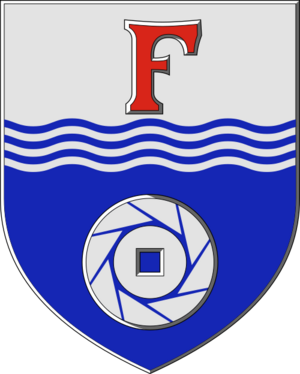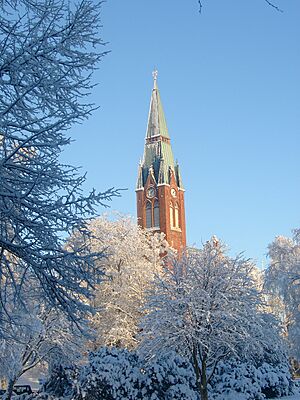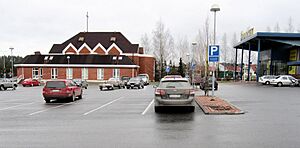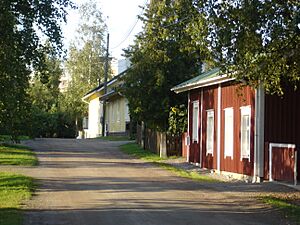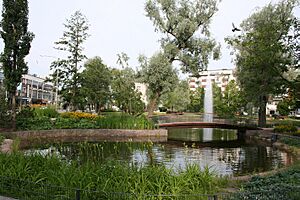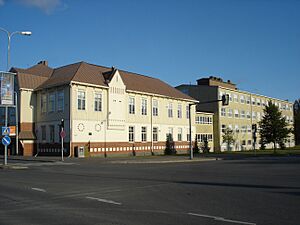Forssa facts for kids
Quick facts for kids
Forssa
|
||
|---|---|---|
|
Town
|
||
| Forssan kaupunki Forssa stad |
||

By the River Loimijoki
|
||
|
||

Location of Forssa in Finland
|
||
| Country | ||
| Region | Kanta-Häme | |
| Sub-region | Forssa sub-region | |
| Charter | 1923 | |
| Town privileges | 1964 | |
| Area
(2018-01-01)
|
||
| • Total | 253.38 km2 (97.83 sq mi) | |
| • Land | 248.84 km2 (96.08 sq mi) | |
| • Water | 4.61 km2 (1.78 sq mi) | |
| Area rank | 246th largest in Finland | |
| Population
(2023-12-31)
|
||
| • Total | 16,469 | |
| • Rank | 67th largest in Finland | |
| • Density | 66.18/km2 (171.4/sq mi) | |
| Population by native language | ||
| • Finnish | 91.8% (official) | |
| • Swedish | 0.3% | |
| • Others | 7.9% | |
| Time zone | UTC+02:00 (EET) | |
| • Summer (DST) | UTC+03:00 (EEST) | |
| Website | www.forssa.fi | |
Forssa is a cool town and municipality in Finland. It's located almost in the middle of a triangle formed by Finland's three biggest cities: Helsinki, Turku, and Tampere. You can find it in the Kanta-Häme region.
Major roads like Highway 2 (between Pori and Helsinki) and Highway 10 (between Turku and Hämeenlinna) pass through Forssa. The town has about 16,469 people. It covers an area of 253.38 square kilometres (97.83 sq mi), with a small part being water.
The Loimijoki river is a very important part of Forssa's landscape. Other cool water spots include Kaukjärvi lake and Koijärvi lake. Koijärvi is famous as the starting point of the Green League political party.
Even though the town's name "Forssa" comes from the Swedish word for "rapids," everyone here speaks Finnish. Forssa is the main town in the Forssa sub-region, which also includes nearby places like Jokioinen and Tammela.
Forssa grew a lot in the 1800s because of the textile industry. After some ups and downs, the food industry is now a big employer. Its location between Helsinki, Turku, and Tampere makes it a great spot for quick trips to bigger cities. Helsinki is 110 km away, Tampere is 87 km, and Turku is 88 km.
Contents
History of Forssa
The story of Forssa becoming an industrial town began in 1847. That's when a person named Axel Wilhelm Wahren started a spinning mill by the Loimijoki river. Today, this old industrial area is seen as a very important cultural site in Finland.
In 1903, a big meeting for the Finnish Workers' Party happened in Forssa. At this meeting, the party changed its name to the Social Democratic Party of Finland and decided on a new plan.
Forssa became its own independent municipality in 1923. Before that, it was part of Tammela. It officially became a city in 1964. The early 1990s were a tough time for Forssa, with many jobs lost, but things have improved since then.
Forssa's Coat of Arms
The current coat of arms for Forssa was designed in 1962 by Olof Eriksson. It shows a silver waterwheel on a blue shield. This design represents the power of water and the Loimijoki river that flows through the city. It was officially adopted on August 29, 1962.
Before this, Forssa had a different coat of arms from 1947. It had a wavy design with a waterwheel and a red letter "F". However, this older design was later changed because it didn't follow traditional heraldry rules.
Population in Forssa
Forssa's population has changed a lot over the years. In 1925, after it became its own municipality, about 7,681 people lived here. The population grew slowly at first, but then it started to increase faster.
By 1968, Forssa had over 13,000 residents. When the nearby area of Koijärvi joined Forssa in 1969, the population jumped to over 15,000. The city continued to grow quickly in the 1970s.
The highest population Forssa ever had was in 1985, with 20,074 people. After the mid-1990s, the population started to decrease. However, it increased slightly in 2008 for the first time in many years. As of late 2016, there were about 17,300 people living in Forssa.
Most people in Forssa live in the main urban area, which is quite busy. The northern parts of the city are more rural and have fewer people. The main urban area of Forssa also extends into the neighboring municipalities of Jokioinen and Tammela.
New neighborhoods have been built around the older parts of the city over time. Areas like Viksberg and Tölö grew in the 1970s and 1980s. More recently, new houses have been built on the city's edges, and new apartment buildings have appeared in the city center.
In 2011, about 13.5% of Forssa's population was under 15 years old. Most children live in newer housing areas. The number of older people has increased, and they often live in areas like Korkeavaha and the city center.
Most people in Forssa speak Finnish. While the number of Finnish speakers has slightly decreased, the number of people speaking other languages has grown a lot.
Churches and Religious Groups
In 2023, the Evangelical Lutheran Church of Finland was the largest religious group in Forssa, with about 70.9% of the population. Other religious groups made up 2.3%, and 26.8% of the people had no religious affiliation.
Forssa has its own Evangelical Lutheran Church congregation. There's also an activity center for the Hämeenlinna Orthodox congregation, a Jehovah's Witnesses Kingdom Hall, and a Pentecostal Salem church. The Evangelical Free Church of Finland also has a presence here.
Geography of Forssa
Forssa has a total water area of only about 4.61 square kilometers, which is a small part of its total size. The main water features in the city are part of Kaukjärvi lake, the Loimijoki river, and smaller lakes like Linikkalanlammi and Mäkilammi. The biggest lake nearby is Pyhäjärvi in Tammela.
The Jänhijoki river, which flows into the Loimijoki, runs through the rural parts of Forssa. In the northern area, you'll find the bird lake of Koijärvi. The Koijoki river starts from Koijärvi and flows west.
Parks and Green Spaces
Forssa has 110 parks, covering a large area of 303 hectares! Many of these are natural green spaces. Some of the most well-known parks include:
- Ankkalammi Park: Located near the market square, it was recently updated.
- Yhtiönpuisto Park: Also called Wahren Park, it's close to the old spinning mill.
- Central Park: A natural park along the Loimijoki river, it also has a football field.
- Talsoila Park: A mix of built and natural areas, open for everyone to enjoy.
- Rantapuisto Park: Found on the riverbank across from Central Park.
- Harjupuisto Park: A forest park filled with pine trees.
- Mäkilammi Park: Another forest park, bordering Mäkilammi lake.
- Siurila Park: A park in the Viksberg area with two ponds and a fountain.
National Urban Park
Forssa is special because three areas within the city have been named a national urban park. These areas show off different parts of Forssa's nature and history:
- Farmland: The Haudankorva and Kuusto areas are recognized for their beautiful farming landscapes.
- Industrial History: Old factory buildings and historic neighborhoods like Kalliomäki and Kuhala are preserved for their industrial heritage.
- Esker Areas: Places like Hunnari and the areas around Lamminranta pond are known for their unique natural ridges called eskers.
Transportation in Forssa
Forssa is connected by several important roads:
- Finnish national road 2: Connects Helsinki to Pori, passing through Forssa.
- Finnish national road 10: Connects Turku to Hämeenlinna, also through Forssa.
There have been discussions about improving Finnish national road 2 to make travel faster. The road was improved near Forssa between 2006 and 2009, including a new bridge.
The Turku–Toijala railway used to pass through Matku, but trains no longer stop there. The old train station is gone. Forssa itself doesn't have its own railway connections anymore. The closest passenger train station is in Humppila. There are ideas to build new railway lines to Forssa in the future.
The Forssa Airfield is used for hobby flying. For bigger trips, the closest airports are in Helsinki, Tampere, and Turku.
Districts and Villages
Forssa is divided into different areas for statistics. There are three main areas: Keskustaajama (the central urban area), Parkkiaro (a rural area), and Entinen Koijärvi (the area of the former Koijärvi municipality).
Some of the well-known districts in the central urban area include:
- Haudankorva
- Keskusta (City Center)
- Kuhala
- Linikkala
- Paavola
- Talsoila
- Vieremä
The former municipality of Koijärvi includes areas like Kojo, Matku, and Suonpää. Matku used to be its own small town with a train station, but it's now a smaller village.
Forssa also has many traditional villages, some of which extend into neighboring municipalities.
Businesses and Jobs
In 2009, Forssa had over 8,700 jobs. Most jobs were in services (like shops and offices), followed by the secondary sector (like factories). Agriculture and forestry made up a small part of the jobs.
The textile industry, started by Wahren in the 1800s, was once the biggest employer. Later, the construction industry grew a lot. Today, the food industry is the largest industry in Forssa. Big companies like HK Ruokatalo Oy and Atria have important operations here. You might even see the "Forssan" brand on food products!
Major Employers
Some of the biggest employers in Forssa are:
- The City of Forssa itself
- HKScan (food company)
- Atria (food company)
- Punamusta (printing company)
- Parma (construction company)
- Saint-Gobain Isover (insulation materials)
- Vansco Electronics (electronics)
- The wellbeing consortium of the Forssa region (FSHKY)
Forssa usually has enough jobs for its residents, and many people from outside Forssa also come to work here. However, there have been times when jobs were harder to find, especially in the early 1990s. The unemployment rate has been decreasing since 2016.
Education in Forssa
Forssa has several schools for different age groups.
Primary Schools (Grades 1-6)
There are four primary schools for younger students:
- Heikka school
- Koijärvi school
- Talsoila school
- Vieremä school
Comprehensive Schools (Grades 1-9)
Two schools in Forssa cover all primary and middle school grades:
- Keskuskoulu school
- Akvarelli all-activity house (combines primary school and early education)
Higher Education
For high school, students attend the Forssa Common Lyceum. This school has a long history as one of Finland's oldest countryside secondary schools.
For vocational training (learning specific job skills), there's the education council of southwestern Tavastia. They offer training for both young people and adults. They even have special training for crane operators!
If you want to go to college, the Forssa branch of the HAMK Häme University of Applied Sciences offers higher vocational education.
Other Services
Forssa has its own fire station with a full-time fire brigade. There are also three volunteer fire brigades in Forssa, including Forssan VPK.
Culture and Events
The cultural center of Forssa is located in a historic spinning mill area. The city has several museums and a theater where you can enjoy shows.
Forssa is known for its fun annual events:
- Holjat Festival: A big festival held on the first weekend of August.
- Pick-Nick: A huge gathering for car enthusiasts, one of the biggest in Northern Europe!
- Suvi-ilta Maraton: The second-largest marathon event in Finland, held just before Midsummer.
- Harness Racing: Forssa has a popular track for harness racing, where horses pull a driver in a two-wheeled cart.
- Silent Film Festivals: In late summer and early autumn, you can enjoy old silent movies in Forssa.
Sports
Forssa was one of the host cities for the 1982 FIBA Europe Under-16 Championship for Women in basketball.
Notable People from Forssa
Many talented people have come from Forssa, including:
- Aarne Ervi (1910–1977) - A famous architect.
- Kalevi Aho (born 1949) - A well-known composer.
- Miia Nuutila (born 1972) - An actress.
- Jonna Tervomaa (born 1973) - A popular singer.
- Tuukka Kotti (born 1981) - A professional basketball player.
- Sanni Grahn-Laasonen (born 1983) - A politician.
- Juuse Saros (born 1995) - A professional ice hockey goaltender.
International Connections
Forssa has "twin town" or "sister city" relationships with several cities around the world. This means they share cultural and educational exchanges. Forssa is twinned with:
 Södertälje, Sweden
Södertälje, Sweden Sarpsborg, Norway
Sarpsborg, Norway Struer, Denmark
Struer, Denmark Serpukhov, Russia
Serpukhov, Russia Gödöllő, Hungary
Gödöllő, Hungary Sault Ste. Marie, Canada
Sault Ste. Marie, Canada
Images for kids
See also
 In Spanish: Forssa para niños
In Spanish: Forssa para niños



